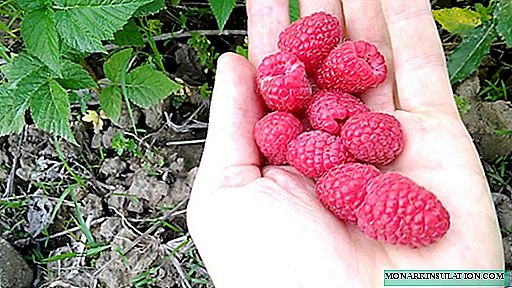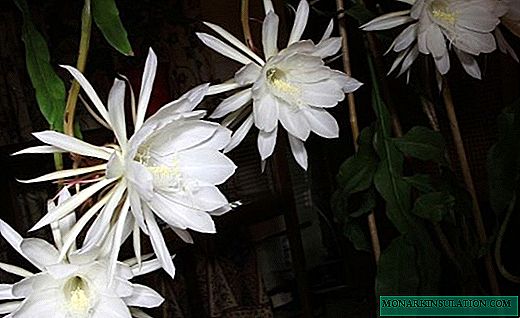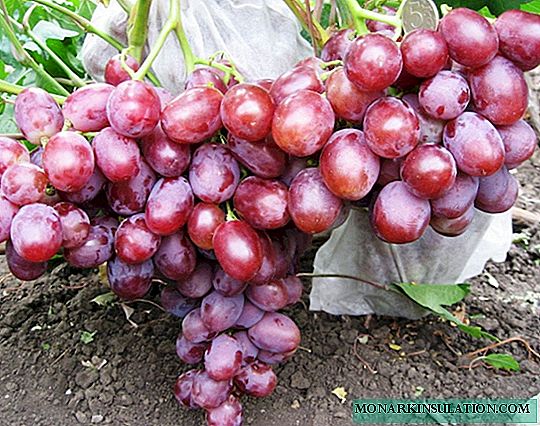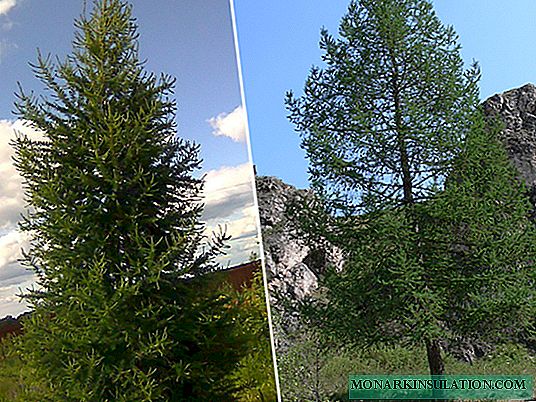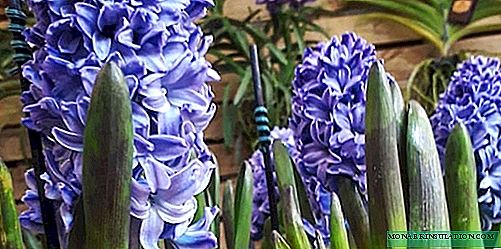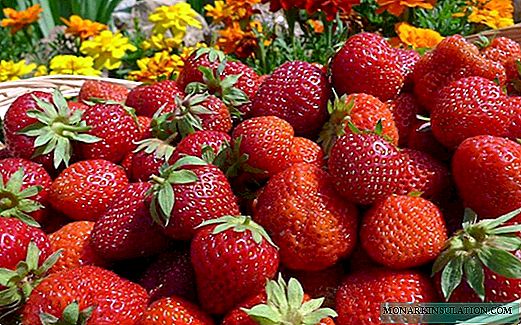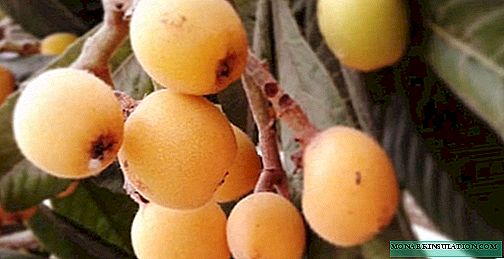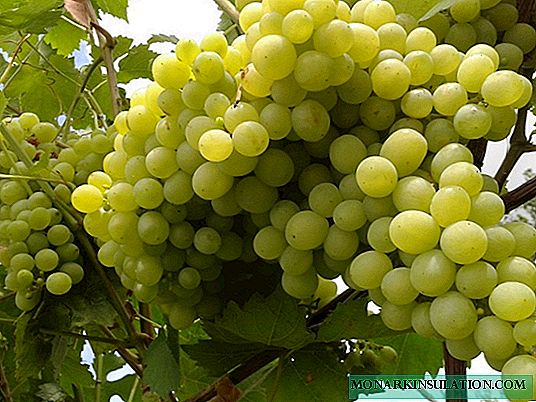
A significant part of the territory of Russia is located in the zone of risky farming. It seems rather ridiculous to talk about growing grapes here. At its mention, the Mediterranean, Transcaucasia and other warm lands come to mind. But there are varieties that can grow in the "wild north." And there are people who are ready to invest their energy, time and soul into this difficult work. About one of these varieties - Aleshenkin - speech will go.
Variety Growing History
This grape has an unusual name - Aleshenkin. The famous Soviet scientist, breeder, academician, and front-line soldier Pyotr Efimovich Tsekhmistrenko named him in honor of his grandson. This variety is also called Alyosha, or quite prosaically - No. 328.
The variety was introduced into the State Register of the Russian Federation under the name Alyoshenkin Dar (code 9553098). Such a variety of names sometimes causes controversy between gardeners about whether one variety is in question.
Peter Efimovich is the author of one and a half dozen varieties of fruit trees, and in 1956 this grape came out of his hands, the result of more than twenty years of work. Academician Tsekhmistrenko lived and worked in Volgograd, where it is hot in the summer, but the winters are harsh. Therefore, the variety bred in these southern regions is able to tolerate frost up to -26 ° C.
Description and characteristics of grapes Aleshenkin
Aleshenkin is a table grape variety. Experts rate its taste quite high - 7 points. It contains a lot of sugar - 16%. Brushes are large, rather loose. The average weight of the brush is 552 g, but sometimes it reaches 1 kg or more. The berries are light green with a pleasant yellowish tint, covered with a waxy coating. The skin is dense, but edible. There are few seeds, usually one or two, and 40% of the berries are completely devoid of them.
The crop matures very quickly, in 110-115 days. Productivity can reach 25 kg from a bush under optimal conditions, but usually - 8-10 kg. Aleshenkin has characteristic five-fingered leaves that distinguish it from other varieties. Although grapes are considered frost-resistant, the underground part suffers from frost more, so in the winter the bushes must be covered.
There are enthusiasts who manage to get a crop even beyond the Arctic Circle. But this, of course, is in the greenhouse.

Large clusters of Aleshenkin grapes ripen very early - in late July
Video: Aleshenkin grape harvest ripened
Features of planting and care
This grape variety is considered quite unpretentious in comparison with others, so it is recommended to beginner gardeners and winegrowers. But certain rules when growing it is better to follow.
Favorite places
Grapes love sunny places protected from the wind, especially the north. The southern slope is best suited. First of all, it warms up in the spring; water does not stagnate there. Grapes do not like waterlogging, in this case fungal diseases can affect it.
Aleshenkin has an average resistance to diseases, but the thing that saves is that in moderate tempera- ture pathogens do not feel very well either, therefore, following agrotechnics, grapes are almost not sick. It is very good to plant grapes under the protection of the walls - a building or a fence that will cover it from the wind. In addition, the building, having warmed up in the sun during the day, will warm the plants at night, giving off its heat. But at the same time, it must be taken into account that rain water from the roof should not drain onto plants.
Grapes prefers fertile, light soil. It does not tolerate wetlands and salt marshes. He does not like acidic soil either - lime must be added. All soil preparation activities are best done in the fall. In the spring, before planting, you should dig the ground so that it is saturated with oxygen and slightly dried out.
Landing rules
It is better to plant grapes in the spring, then by winter it manages to take root and strengthen well. The choice of seedlings should be taken very seriously. Only using high-quality planting material, you can achieve good results. It is better to take seedlings with a closed root system, but if it is open, you need to pay attention to the color of the roots - the lighter the better. If possible, you can cut one - the cut should also be light.
If the root inside is dark, the seedling is of poor quality.
A healthy brown shoot, but light on the cut. Leaflets, if any, should be smooth. The presence of irregularities on them may indicate the infection of plants by pests.

It is preferable to buy seedlings with a closed root system
The landing process itself can be divided into several operations:
- Dig a hole. Depth, width and length are approximately the same, about 60 cm.
- At the bottom we pour drainage - expanded clay, broken brick. If there is a possibility of excess moisture in the soil - the drainage layer can be up to 25 cm.
- On top of the drainage, pour earth, sand and humus (or peat) mixed in equal proportions.
- Add 1-2 tablespoons of complex fertilizer, a shovel of ash.
- Thoroughly spill the hole with water.
- Water the seedling too well, then carefully remove it from the pot and place it in the hole.

Seedlings are placed in a prepared hole at an angle to the surface of the soil and watered abundantly.
- We fall asleep with earth, carefully crush and water again.
Seedlings are placed not vertically, but at an angle to the soil surface. So it will be easier to lay them for the winter. The first few days, seedlings should be watered intensively, and then watered once every two weeks - about 40 liters for each bush.
Spring and summer care
In the spring, after removing the shelter, the vines must be tied to the trellises, and even before the buds appear, carry out the first feeding. For this, an infusion of chicken manure is suitable. It is mixed with water in a ratio of 1: 2, insist a week, then the infusion is diluted in a ratio of 1:10. This solution is applied under plants at the rate of 1 liter per bush. It does not need to be poured directly under the root, it is better to make a circular groove and pour fertilizer into it.
To improve the taste of berries, it is useful to apply potash fertilizers. The most affordable is ash. It is brought either in dry form at the rate of 1 bucket per plant, or in the form of an extract (pour water and insist 3 days).
The very first top dressing can be carried out before the snow melts, scattering granular superphosphate at the rate of 40 g per square meter.
When the bushes reach a height of 1.7 meters, you need to pinch the tops. Leaves that obscure the inflorescences are removed. In the case of dry summers around each bush, you need to make a circular groove so that the water does not flow during irrigation and gets directly to the roots. With high humidity, especially on heavy clay soil, you need to dig through the drainage ditches to avoid damage by the fungus.
Bush formation
Bush growth needs to be controlled. You can not let it grow too much, as this will make it difficult to care and reduce productivity. There are many ways to form a bush. For gardeners who do not have experience growing grapes, a pruning system created in the middle of the 19th century by wine grower Guyot may be suitable.
- In the autumn of the first year, the young shoot is cut short, leaving two eyes above the surface of the soil or from the place of vaccination.
- In the fall of next year, one of the shoots formed is cut short, leaving two eyes (a knot of substitution), and the second is longer, from 4 eyes. It will be a fruit vine.
- The next fall (3rd year), the thawed vine with all the shoots is cut out, and from the shoots grown on the replacement knot, a new replacement knot and a new fruiting vine are formed.
In areas with a temperate and cool climate, fan bush formations are popular. In this case, the first two years, pruning is carried out in the same way as in the Guyot method, and in the third year, 3-4 strong shoots with a thickness of at least 6 mm are selected on the bush, each is cut to a length of at least 50 cm and tied to the lower trellis fan. Moreover, the shoots located on the sides, make longer, and located in the center - shorter. In this way, several "sleeves" or "fruit units" are formed.
The vine usually bears fruit for 6 years, then it becomes too thick and difficult to lay in a trench for wintering. Therefore, the old "sleeves" are cut down, replacing them with young shoots.

Pruning grapes - a very important agricultural event
Wintering
For a successful wintering of grapes, the vines are removed from the trellis, tied, bent to the ground, pinned and covered with a waterproof material. This should be done in dry weather so that excess moisture does not get into the shelter. The optimal time for laying for the winter is from mid-October to mid-November. The average daily temperature should be around 0 ° C. If it is too warm, a “greenhouse” will be created under the film, which will damage the vine. Sprinkle the film with earth, and mulch on top.
It is very good if in winter there will be a lot of snow in the area where the grapes winters. For this, snow retention can be carried out with improvised means.
In spring, the mulch is removed after the snow melts, and the film is a little later, when the plants start to grow. In this case, if the covering material transmits light, it is necessary to ensure access of air to the shelter.
Pest and Disease Control
The problems in this variety are the same as in others. The most dangerous and common fungal diseases are oidium, mildew. Of the pests, the most dangerous are the spider mite, marble chafer, two-year leaflet. Both chemical and agricultural methods are used against them.
Table: Diseases, Pests and Pesticides
| Disease, pest | Nature of defeat | Means of struggle |
| Mildew (downy mildew) | The most common disease. It affects all parts of the plant, yellow spots appear on them, white plaque on the underside of the leaves. Then the affected parts turn brown and die. | Effective:
Three-time processing:
|
| Oidium (powdery mildew) | All parts of the plant look like sprinkled with flour. Affected inflorescences die off, and the berries crack or dry. | Apply:
The processing time is the same as for mildew. |
| Spider mite | It affects the leaves, they turn yellow and dry. This weakens the plant, worsens the growth and ripening of shoots, reduces the yield and sugar content of berries. | Use:
Plants are treated with nitrafen until buds open, then regular treatments with acaricidal preparations are performed according to the instructions. It is very important that the solution falls on the underside of the leaves, where the pest is localized. |
| Marble Crunch | Very dangerous pest. Insects and their larvae gnaw through the roots of plants, which leads to their death. | Insecticides are applied to the soil:
Treatments are carried out in spring or autumn when the pest larvae are in the arable layer. |
| Biennial leaflet | A butterfly whose caterpillars eat flowers, ovaries and damage berries. | Plants in the spring are sprayed with drugs:
|
For the prevention of diseases, it is important to prevent thickening of the bushes, to remove excess shoots in a timely manner. This provides good ventilation and maintains normal humidity. It is very important to dispose of plant debris and not to impede the development of weeds, especially in the spring, when they become a food supply for overwintered pests.
Photo gallery: diseases and pests of grapes
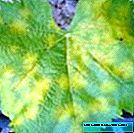
- A characteristic sign of mildew disease is yellow spots on the leaves of grapes.
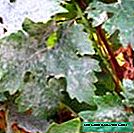
- Powdery mildew plants look sprinkled with flour

- The leaves affected by the spider mite curl and fall
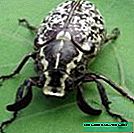
- Marble Khrushchev - brown beetle with white marble elytra pattern

- Two-year leaflet - a butterfly with yellow front wings through which a brown transverse strip passes
Grade Reviews
Aleshenkin is my first grape bought completely green by inexperience. Even there was no millimeter of a lignified part. Despite the lack of experience, he still wintered and grew, although I transplanted it in search of the best place. He had been ill for more than six years without treatments and only last summer I found out what mildew was on it. I removed all the clusters, although there were a lot of them and treated, treated. I really wanted to keep the variety ripening in any summer, tasty and beautiful. The vines matured by seven buds. This year, even on awakened eyes, there were flowers on the old sleeves, and on the mustache and on the vines, two, but mostly three, clusters. No matter how bad it was, she left one. Now I’m spraying it. I really want to protect it from diseases. Whatever it is, I won’t refuse Alyoshenkin. I’d better take care of it.
Lala//www.vinograd7.ru/forum/viewtopic.php?t=672&p=339736
Aleshenkin is the very first grape on my plot and so far the most favorite, a sort of standard by which I compare all other varieties to taste, ripening.
Victor Grebenichenko//new.rusvinograd.ru/viewtopic.php?t=61
Aleshenkin, like its creator, is a variety with character. But if you get used to it, it's wonderful. I have 2 vines in the wall culture. In 2007, it matured as early as August 10, and this is in the suburbs.
Talinka//forum.vinograd.info/showthread.php?t=527
We do not grow many varieties, but Aleshenkin is considered very good. At least to take into account that we have thirty-degree frosts every winter, then he suffers a winter sheltered very well. And he has time to ripen, which makes the northern wine-grower happy.
Reg Old Timer//forum.vinograd.info/showthread.php?t=527&page=3
There are no ideal varieties. Each has its pros and cons. Aleshenkin is no exception. But this, of course, is a wonderful variety, our national treasure, worthy of respect, care and love.







